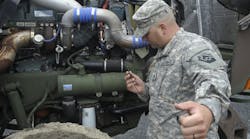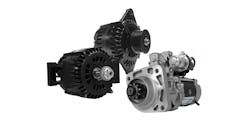Here’s a question for you: how much is a 1% gain in Class 8 fuel economy worth? Can you put a dollar figure to it?
Apparently Gary Parsons, the global OEM and industry liaison manager for the products and technology division at Chevron Oronite Company, can – and according to his calculations a 1% improvement in fuel economy is worth $500 to $700 per year in cost savings.
And that’s why Parsons believes truckers – be they owner-operators or big fleets – should embrace the impending changeover to CK-4 and FA-4 diesel engine oils on Dec. 1; the official names for oils developed over the last five years under the Proposed Category 11 or “PC-11” label.
“Unlike with aerodynamic devices or low rolling resistance (LRR) tires, you can change the kind of oil you are using with low cost and implement it across entire your fleet immediately – affecting fuel economy overnight,” he explained during a webinar this week hosted by Chevron Lubricants.
If a fleet switches from current CJ-4 15W-40 oils to the new CK-4 10W-30 grade, Parsons said they’ll attain 1% improvement in fuel economy. If the fleet switches to the lower viscosity CK-4 5W-30 grade, the fleet would see an extra 0.2% gain in fuel efficiency.
And if the fleet decided to switch to the new super-fuel efficient FA-4 5W-30 grade – a grade, however, that will only be allowed right now for use in a few select engine models – the fleet would get another 0.2% on top of that, for an overall gain of 1.4% versus the current CJ-4 15W-40 grade.
[As an aside, Rommel Atienza – North American Delo commercial brand manager – added that Chevron Lubricants plans to keep supplying CJ-4 for at least a year following the rollout of CK-4 and FA-4, providing a good length of time for customers to switch over to the new grades.]
Yunsu Park, the program manager for confidence reports at the North American Council for Freight Efficiency (NACFE) added that fleets his group works with that’ve already switched to current CJ-4 10W-30 blends are seeing some significant gains in fuel economy.
He said NACFE’s partner fleets experienced fuel economy gains ranging from 0.5% to just over 2% in some specific cases by switching to the 10W-30 grades currently on the market.
“The data is very consistent,” Park stressed during the webinar. “We recommend fleets implementing this change; going from a 15W-40 grade to a 10W-30 grade in same [oil] category.”
Interestingly, NACFE’s research into engine oils found this is one area where even so-called “forward-thinking” fleets are actually reluctant to make changes.
“Over 40% of the NACFE fleets still use the 15W-40 grade, and these fleets are typically fairly aggressive with new technology,” Parks noted. Industry-wide, less than 20% of Class 8 fleets are using something other than the 15W-40 engine oil grade, he added.
A separate conclusion NACFE derived from examining FA-4 grade field test data over the summer indicates fleets could get a further 0.4% to a 0.7% improvement in fuel economy over current 15W-40 blends, but Parks stressed that his “information is still very limited” and that more testing is needed to confirm that potential gain.
But Parks also remains “confident” in NACFE data that that higher viscosity oils don’t provide better engine protection than the 10W-30 and thinner viscosity grades.
“We believe the 10W-30 grade provides good protection,” he stressed.
Yet there is a challenge: price. For while there is no upfront investment to the level required by adding aerodynamic devices or LRR tires, Parks said fleets moving from a 15W-40 oil to a 10W-30 or 5W-30 grade will see a cost increase.
“Your return on investment [ROI] can be achieved, but you need to investigate that on your own,” he noted.
[Len Badal, the global Delo brand manager for Chevron Lubricants, said much the same thing to me in an earlier interview you can read here.]
Part of that ROI calculation needs to include longer drain intervals, for both the CK-4 and FA-4 grades.
For example, one fleet attending the webinar noted that the drain interval on its 200 trucks using CJ-4 grade oil is around 35,000 miles. With CK-4, that interval could be over twice as long.
PACCAR, for instance, recently announced a drain interval of 75,000 miles for its 2017 model MX-11 and MX-13 engines – a boost of over 15,000 miles from its current 60,000 miles limit – though that number may need to be pulled back if a fleet’s engine idle time is greater than 20%.
Cummins is allowing for a drain interval extension in its new X15 engine line of up to 80,000 miles – with something similar in the works for its X12 engine as well, which will be introduced in 2018 – if fleets use its new OilGuard oil analysis service.
Yet NACFE’s Parks also noted that the potential for easily-attainable fuel economy gains is there with the new CK-4 and FA-4 grades and he expects thinks truckers will take advantage of that opportunity.
“We really see the new oils coming on to the market [Dec. 1] as a chance for fleets to re-evaluate their choices based on the fuel economy impact of low viscosity oil,” he said.
We’ve got less than a month to go before we start finding out which fleets will switch and which will stand pat.





